Having previously explored the widely acclaimed Hamilton Khaki Field Mechanical, I recognized its merits as a field watch, yet it personally left me desiring something more refined. While the Khaki Field Mechanical serves its functional purpose admirably, my inclination leaned towards a field watch that offered enhanced aesthetics and a more premium feel. Fortunately, Hamilton’s collection includes the Khaki Aviation Pilot Pioneer Mechanical, a timepiece that perfectly aligns with this desire for a field watch elevated in both design and execution.
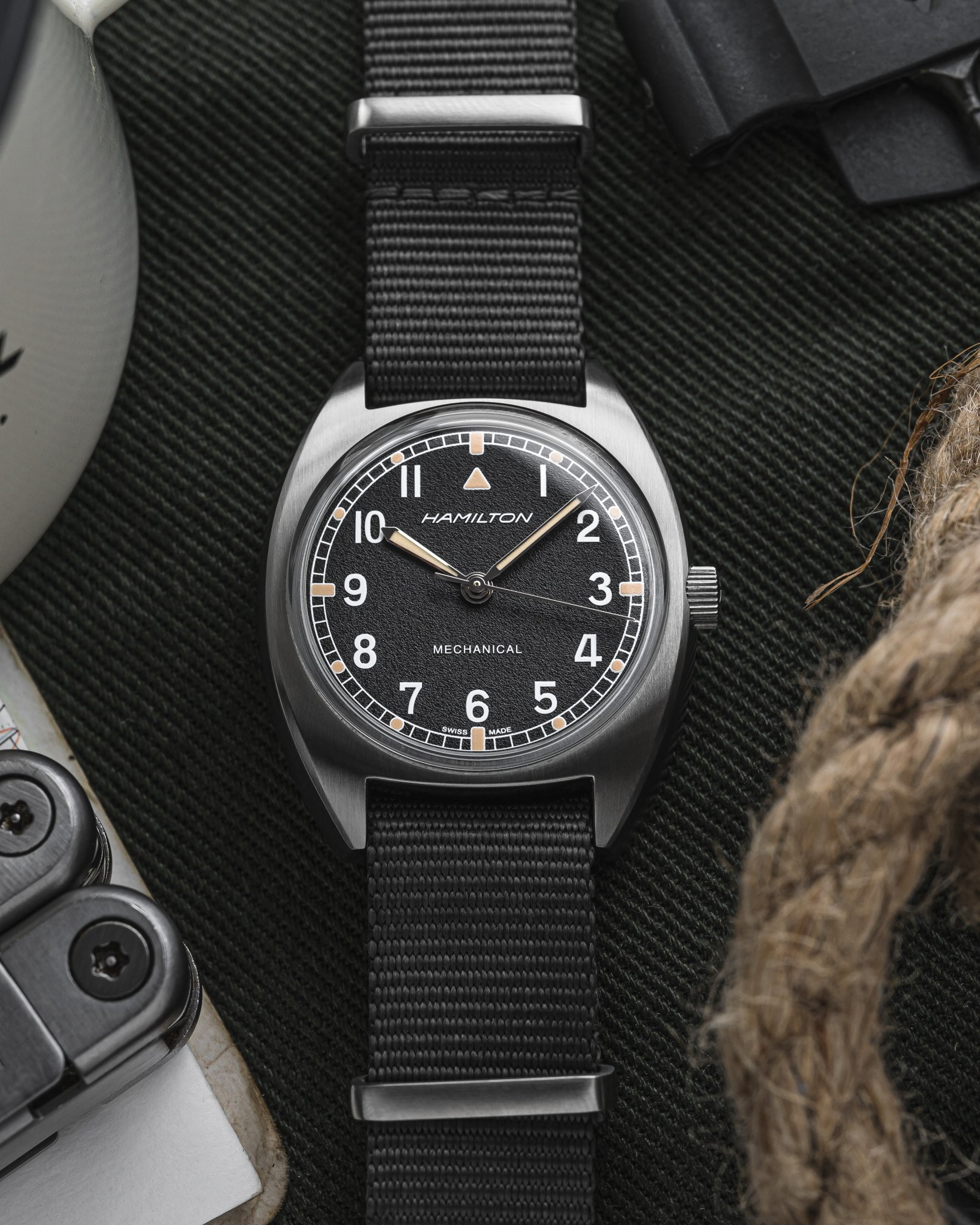 Hamilton Khaki Aviation Pilot Pioneer Mechanical
Hamilton Khaki Aviation Pilot Pioneer Mechanical
The Hamilton Pilot Pioneer is essentially a faithful recreation of the Hamilton W10, a watch issued to all branches of the British military between 1973 and 1976. This historical context clarifies the “Pilot Pioneer” designation, revealing it to be more of a general service watch design rather than one specifically tailored for pilots. Despite the name, its robust and legible design speaks to its military heritage and versatile functionality.
Heritage and Design Inspiration
The Hamilton W10, the Pilot Pioneer’s ancestor, holds a significant place in military watch history. Its design ethos prioritized functionality and durability for military personnel across various branches. The reissue, the Pilot Pioneer, meticulously captures this essence, offering a tangible link to military heritage. While marketed under the Khaki Aviation line, the Pilot Pioneer’s design is rooted in general service watch principles, making it a versatile timepiece for everyday wear, appealing to enthusiasts of military and vintage-inspired watches alike.
Justifying the Price Difference
Initially, the Pilot Pioneer’s retail price, significantly higher than the Khaki Field Mechanical, seemed perplexing. However, upon closer examination and direct comparison, the rationale becomes evident. The price difference reflects a tangible elevation in finishing and overall quality. Every aspect of the Pilot Pioneer exhibits a higher standard of craftsmanship, suggesting considerably higher production costs for Hamilton. If Hamilton maintains a consistent profit margin across their lines, the increased production cost directly translates to the retail price disparity. The Pilot Pioneer isn’t just a different model; it’s demonstrably a more meticulously crafted timepiece.
 Hamilton Khaki Aviation Pilot Pioneer Mechanical
Hamilton Khaki Aviation Pilot Pioneer Mechanical
This detailed examination will explore precisely why the Pilot Pioneer distinguishes itself as a superior watch compared to the Khaki Field Mechanical, delving into its various components and design elements.
The Case: Classic and Refined
Starting with the case, the Pilot Pioneer immediately sets itself apart. Mirroring the original W10, it features a distinctive tonneau or cushion-shaped case, finished with brushing. This brushed finish maintains the tool-watch aesthetic crucial for a field watch, but simultaneously imparts a level of refinement absent in the bead-blasted finish of the Khaki Field Mechanical. The brushing catches the light subtly, adding visual interest without compromising its utilitarian appeal.
The case dimensions are true to its vintage inspiration and designed for comfortable wear: a modest 36mm diameter, a 41mm lug-to-lug measurement, and a 10mm thickness. Hamilton commendably resisted the modern trend of upsizing vintage designs, retaining the authentic proportions of the original Hamilton W10. While the 36mm size might be considered small by contemporary standards, it aligns perfectly with the historical context and provides a comfortable, unobtrusive presence on the wrist.
 Hamilton Khaki Aviation Pilot Pioneer Mechanical
Hamilton Khaki Aviation Pilot Pioneer Mechanical
Vintage-Inspired Crystal and Water Resistance
Further enhancing the Pilot Pioneer’s vintage authenticity, Hamilton opted for a boxed mineral crystal. This crystal shape deliberately mimics the acrylic crystals found on the original W10, contributing significantly to the watch’s retro charm. The crystal sits proudly above the case, a characteristic feature of vintage military watches, successfully capturing the intended aesthetic. However, the choice of mineral crystal over sapphire is a point of contention. Sapphire crystal is renowned for its superior scratch resistance, and its absence in the Pilot Pioneer is a notable compromise, particularly at its price point.
Despite this, the mineral crystal on the Pilot Pioneer offers a redeeming feature: a double anti-reflective coating. This coating is exceptionally effective in minimizing glare, ensuring excellent legibility even in bright sunlight. In terms of water resistance, the Pilot Pioneer boasts 100m, doubling the Khaki Field Mechanical’s 50m rating. This improvement offers greater peace of mind and allows for swimming and water activities without concern, a practical upgrade for everyday wear.
 Side view of the Hamilton Pilot Pioneer watch, showing the boxed mineral crystal and its profile.
Side view of the Hamilton Pilot Pioneer watch, showing the boxed mineral crystal and its profile.
NATO Strap: Quality and Comfort
Staying true to its military origins, the Pilot Pioneer is fitted with an 18mm grey NATO strap. This is not a generic, off-the-shelf NATO strap; it’s a noticeably higher quality strap, far superior to inexpensive alternatives. The material feels durable yet comfortable on the wrist, enhancing the overall wearing experience. A unique detail, however, is the leather covering at the strap’s tip and pinholes. While potentially adding a touch of refinement, this leather reinforcement increases the strap’s thickness, making it too bulky to neatly tuck back into the keepers, a minor inconvenience in daily use.
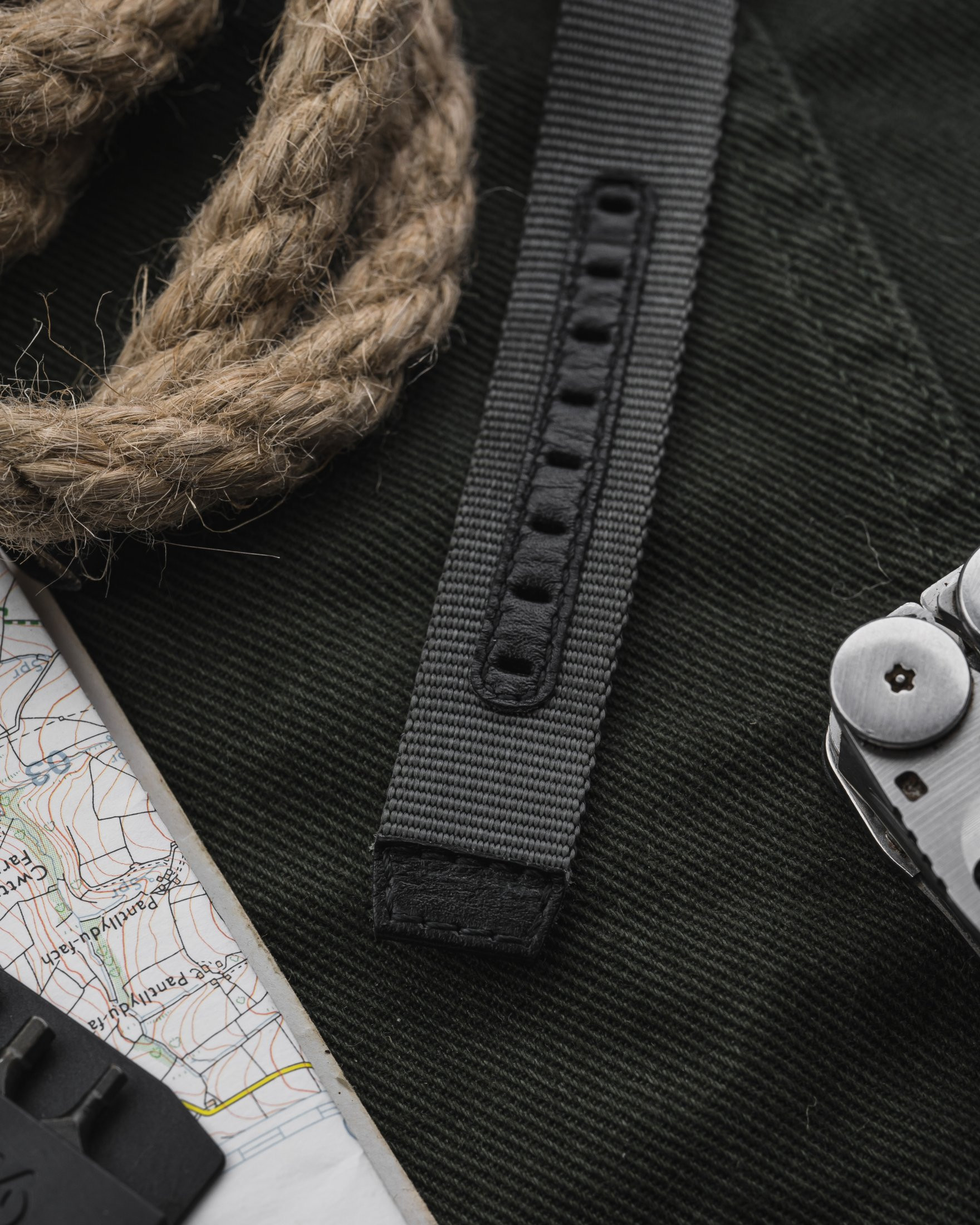 Close-up of the grey NATO strap on the Hamilton Pilot Pioneer watch, focusing on the leather detailing at the tip.
Close-up of the grey NATO strap on the Hamilton Pilot Pioneer watch, focusing on the leather detailing at the tip.
Dial Details: Where the Pilot Pioneer Excels
The dial is where the Pilot Pioneer truly distinguishes itself and justifies its premium over the Khaki Field Mechanical. While the KFM’s dial is straightforward and functional, the Pilot Pioneer’s dial is rich in textures and details that captivate the eye. The dial surface itself features a subtle, sandpaper-like finish. This texture is not overtly pronounced but provides just enough surface interest to prevent the dial from appearing flat or dull, adding a tactile dimension to the visual appeal.
The dial printing closely mirrors the original W10, featuring a classic railroad minute track, Arabic numerals from one to eleven, and the iconic arrow at the twelve o’clock position. Hamilton even incorporated their period-correct logo with an italicized font, further enhancing the vintage authenticity. While these elements are typical of field watch designs, the Pilot Pioneer elevates them with the use of faux-aged lume on the minute track and handset. “Fauxtina,” as it’s often called, is a polarizing feature, but in the Pilot Pioneer’s case, it works exceptionally well. The creamy lume provides a subtle yet effective touch of color, injecting warmth and vintage character into the dial without appearing artificial or overdone. However, it’s worth noting that while the lume achieves the desired vintage aesthetic, its luminosity is not exceptionally bright in low-light conditions.
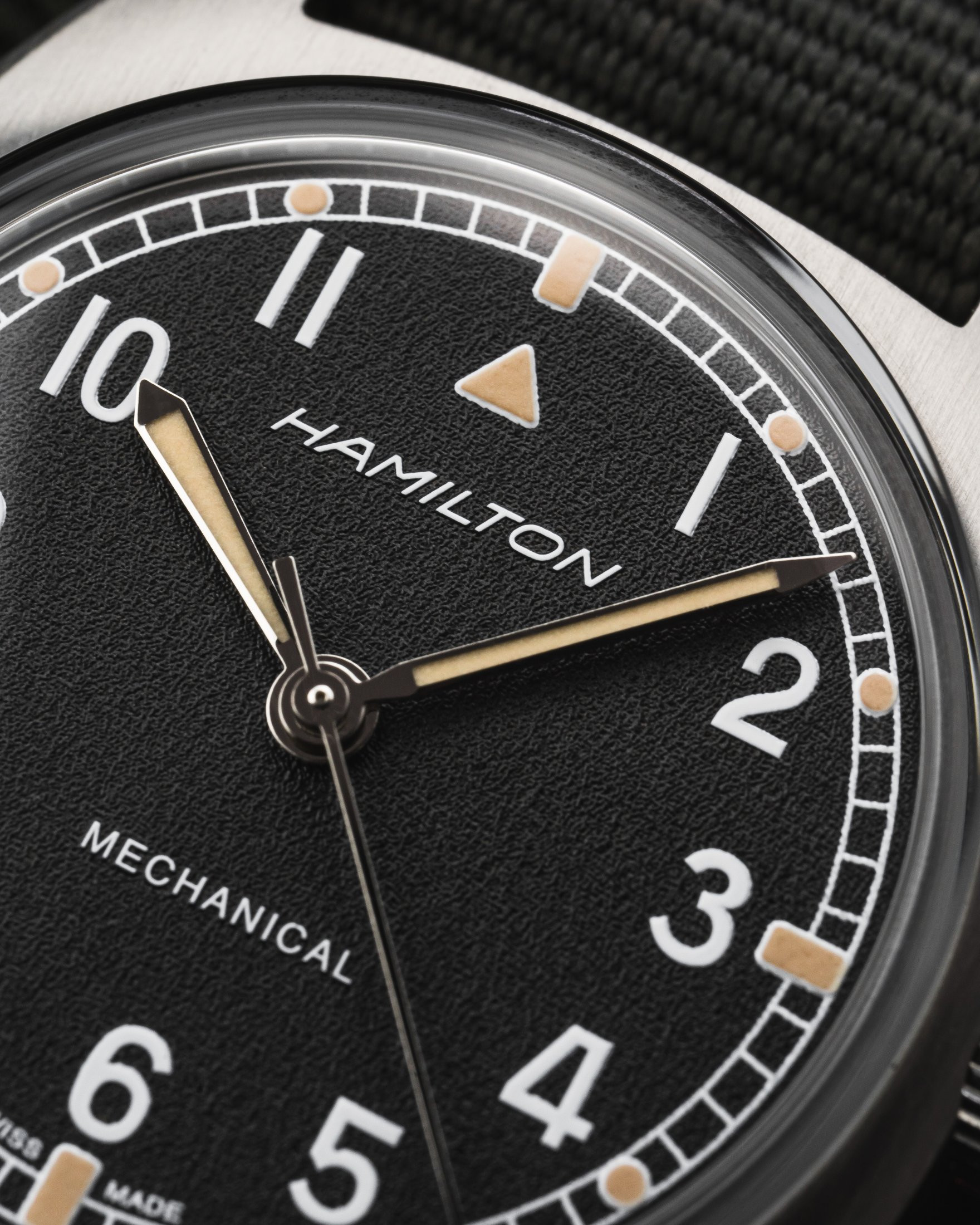 Macro shot of the Hamilton Pilot Pioneer watch dial, emphasizing the sandpaper texture and faux-aged lume.
Macro shot of the Hamilton Pilot Pioneer watch dial, emphasizing the sandpaper texture and faux-aged lume.
Finally, the simple sword-style handset is finished with polished, rounded surfaces. This subtle detail is often overlooked but significantly impacts the watch’s overall impression. The rounded, polished hands catch and reflect light dynamically, creating subtle shifts in appearance depending on the viewing angle, adding a layer of visual depth and interest compared to flat, stamped hands. Overall, the Pilot Pioneer’s dial remains highly legible, as expected of a field watch, while incorporating enough nuanced details to make the familiar military design feel distinctly more refined and special.
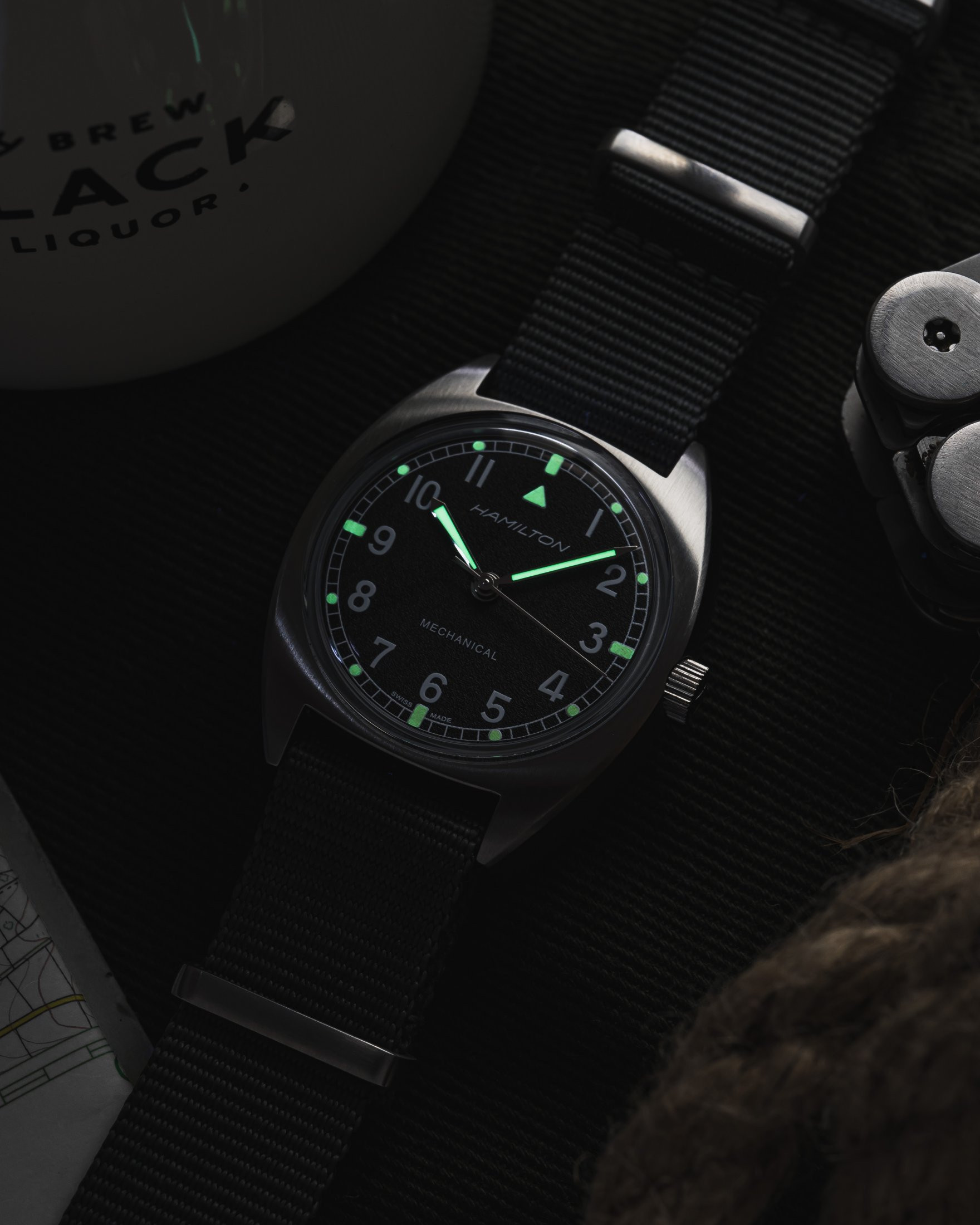 Lume shot of the Hamilton Pilot Pioneer watch in low light, displaying the faux-aged luminous material on the dial and hands.
Lume shot of the Hamilton Pilot Pioneer watch in low light, displaying the faux-aged luminous material on the dial and hands.
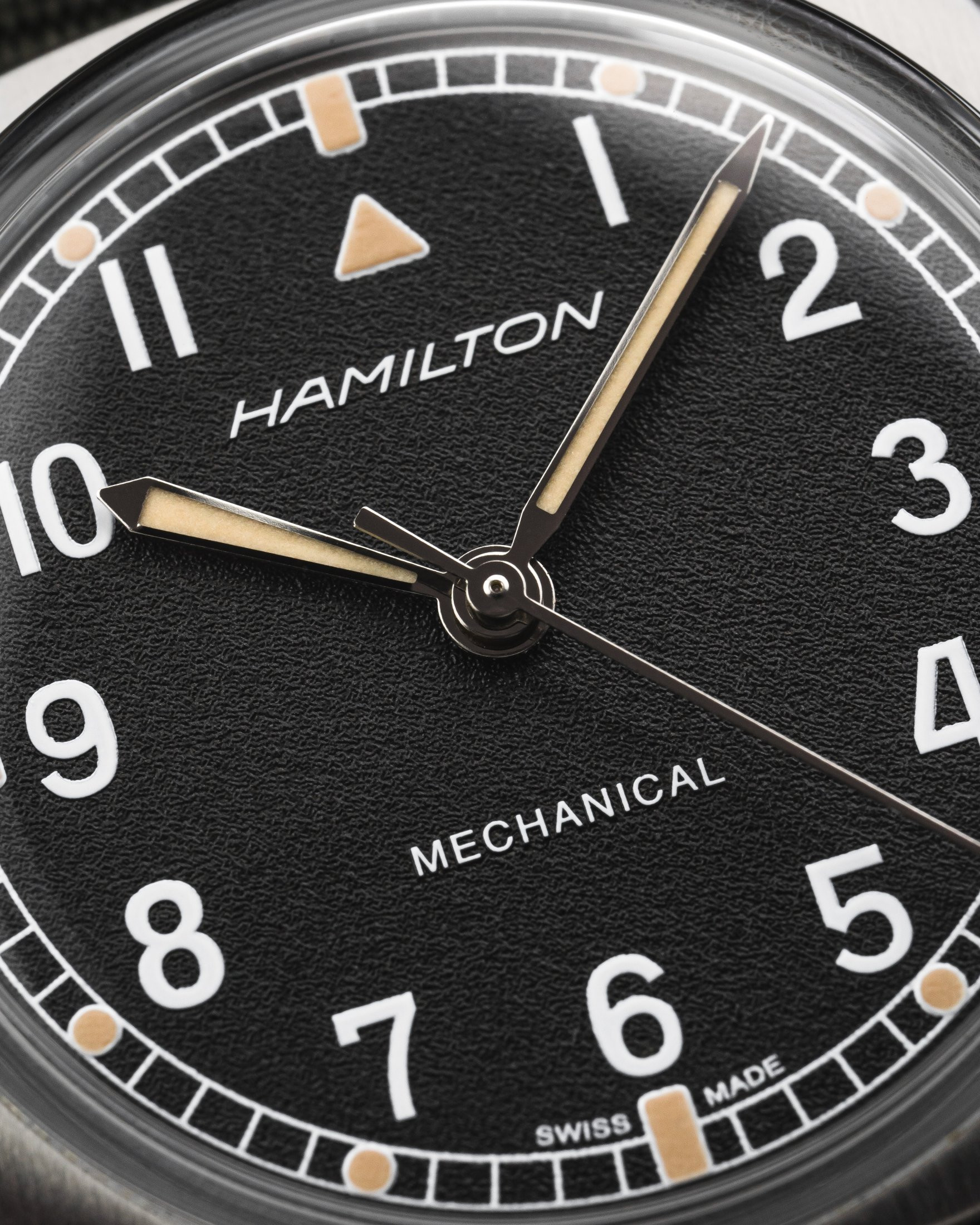 Angled view of the Hamilton Pilot Pioneer watch, showcasing the dial, case, and sword hands in natural light.
Angled view of the Hamilton Pilot Pioneer watch, showcasing the dial, case, and sword hands in natural light.
Movement: Reliable and Long-lasting
Internally, the Pilot Pioneer shares the same robust H-50 movement with the Khaki Field Mechanical. This movement is based on the ETA 2801-2, modified by Hamilton, featuring 17 jewels, a 3Hz beat rate, and an impressive 80-hour power reserve. The extended power reserve is a significant advantage, particularly in a manual-wind watch, offering convenience and flexibility in daily use. The H-50 has proven to be a reliable and well-regarded upgrade to the established ETA caliber, ensuring dependable performance.
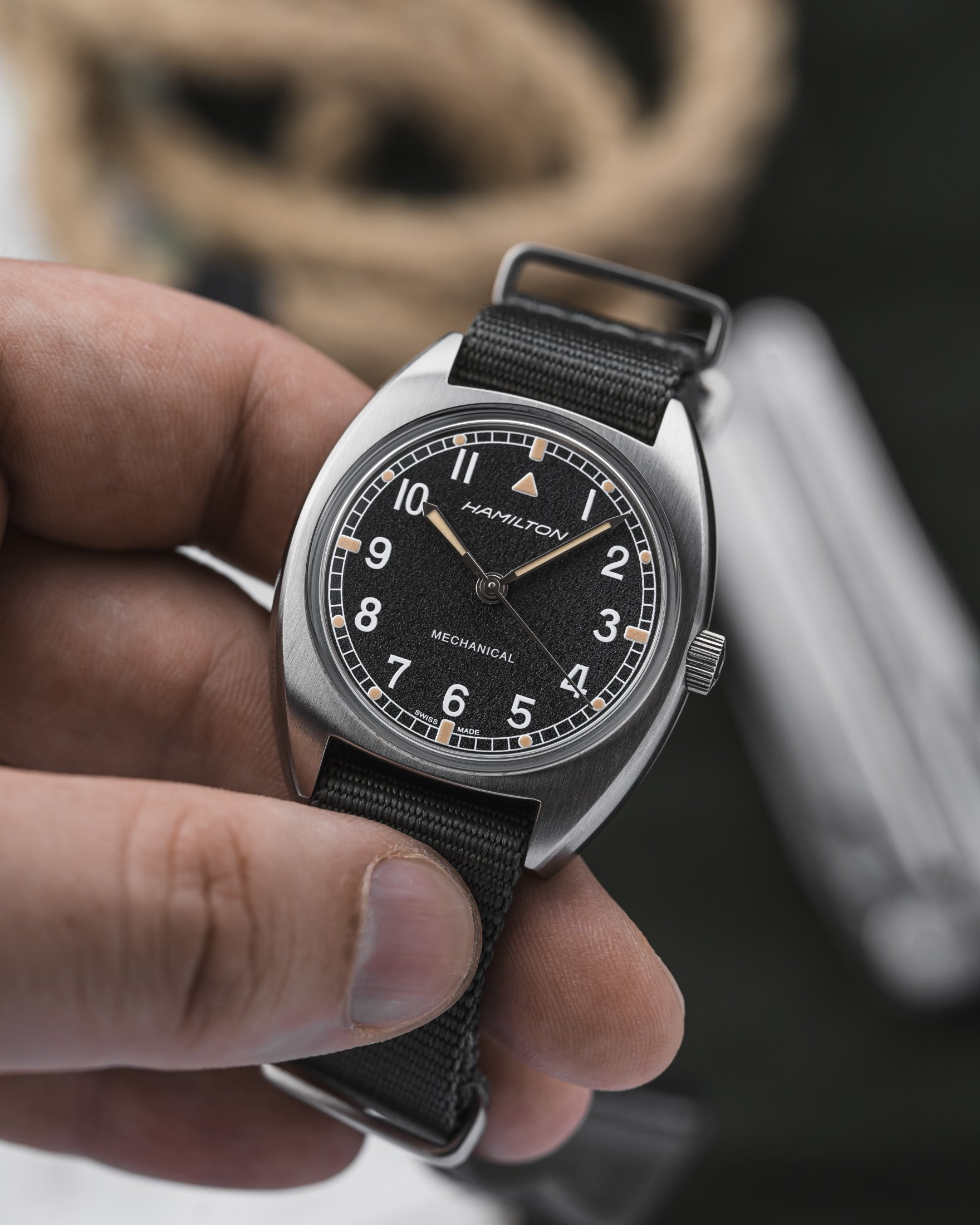 Back view of the Hamilton Pilot Pioneer watch, although the movement is not visible, representing the internal H-50 calibre.
Back view of the Hamilton Pilot Pioneer watch, although the movement is not visible, representing the internal H-50 calibre.
Conclusion: A Step Up in the Field Watch Game
For those seeking a field watch that transcends basic functionality and offers a more refined and historically-inspired experience, the Pilot Pioneer convincingly outshines the Khaki Field Mechanical. Its superior finishing and attention to detail elevate it to a different class. While the Khaki Field Mechanical prioritizes pure utilitarian function, the Pilot Pioneer appeals to those who appreciate subtle nuances and a touch of vintage charm in their field watch. If a purely functional aesthetic is preferred, the KFM remains a viable and more budget-friendly option, offering similar core features at a lower price point.
However, for enthusiasts who value the finer details and are willing to invest slightly more for a watch that feels distinctly more special, the Pilot Pioneer is compelling. The mineral crystal remains the only notable drawback, but its excellent anti-reflective coating mitigates some of the concerns. Ultimately, the Hamilton Khaki Aviation Pilot Pioneer Mechanical is a charming and expertly executed reissue of a classic military field watch. While its retail price might seem steep relative to the KFM, acquiring it on the secondary market, often at a significant discount, presents an exceptional value proposition. Purchasing a Pilot Pioneer pre-owned allows access to a watch that delivers a noticeable step up in quality and refinement for a price that becomes highly competitive and justifiable.
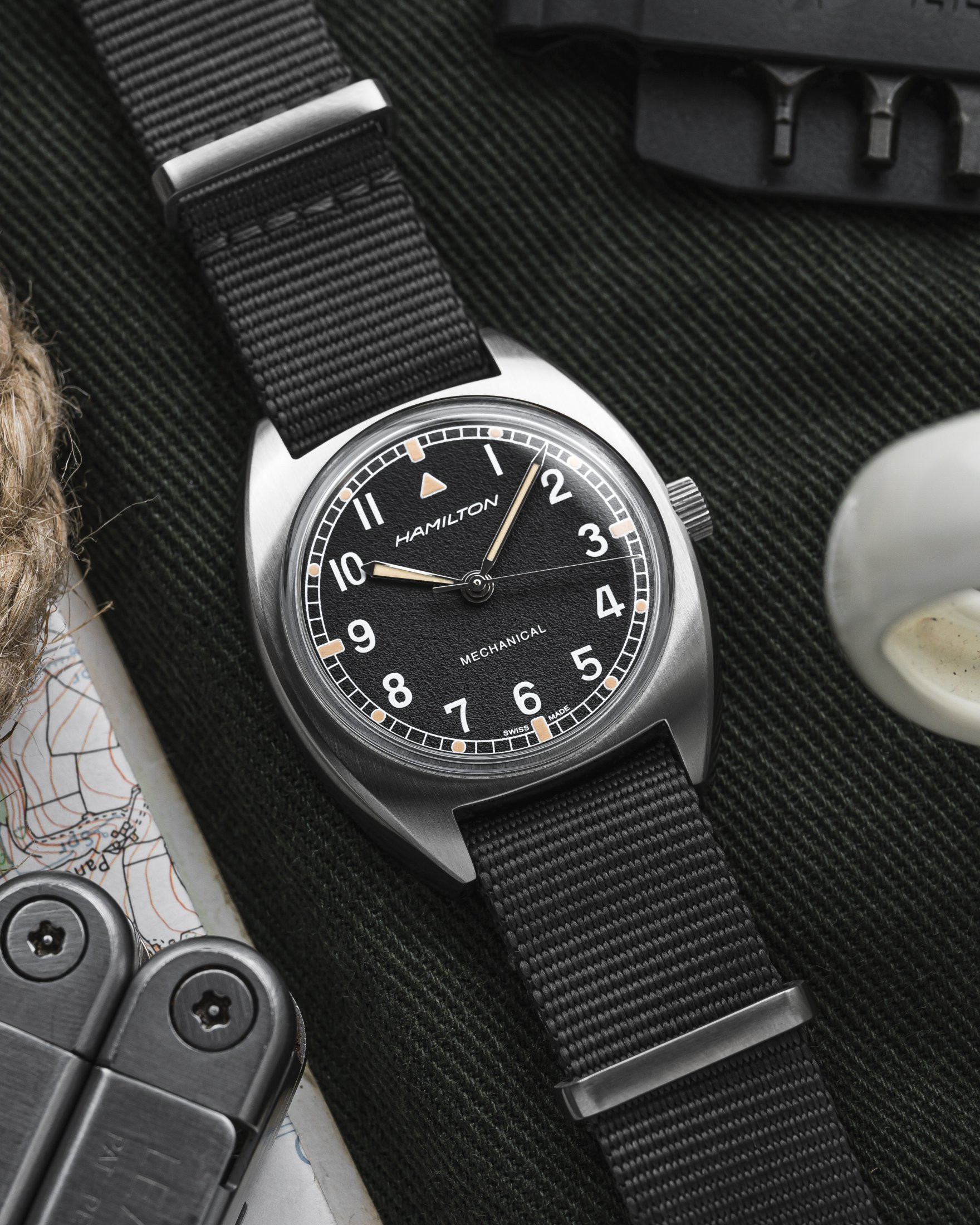 Hamilton Khaki Aviation Pilot Pioneer Mechanical watch on wrist in a natural outdoor setting, summarizing its appeal as a stylish field watch.
Hamilton Khaki Aviation Pilot Pioneer Mechanical watch on wrist in a natural outdoor setting, summarizing its appeal as a stylish field watch.
For those interested in exploring further, the Hamilton Khaki Aviation Pilot Pioneer can be found directly on Hamilton’s website here.


